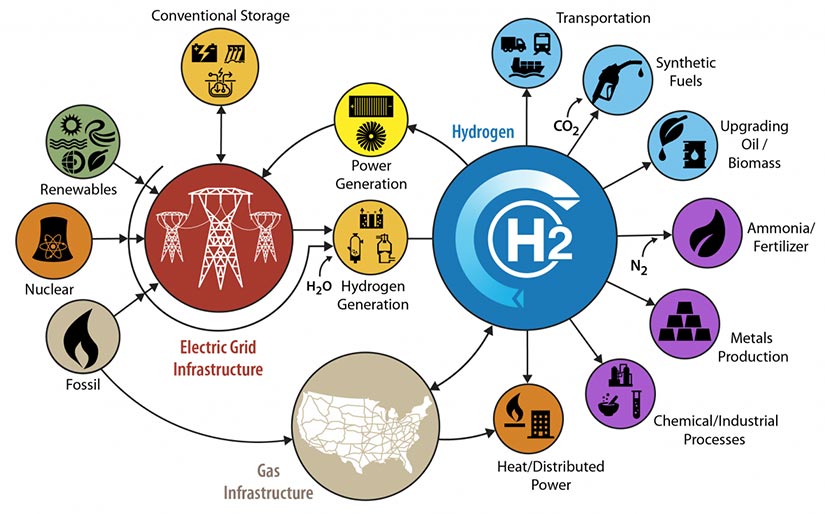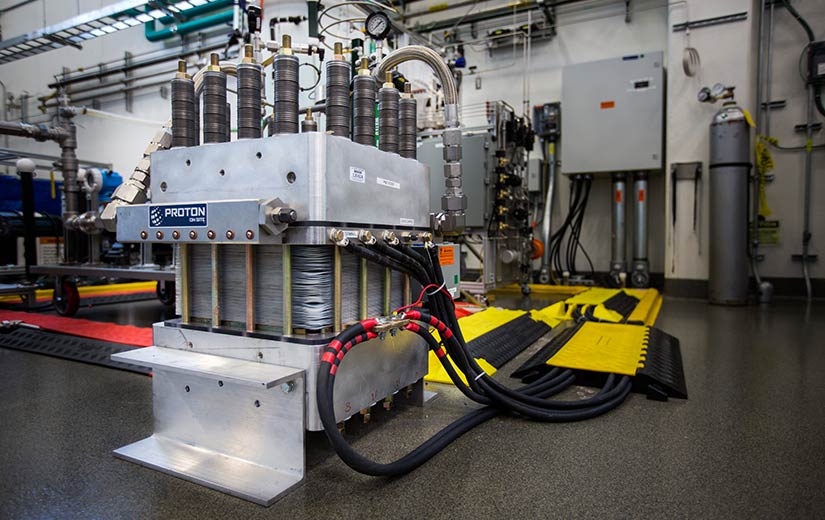Study Shows Abundant Opportunities for Hydrogen in a Future Integrated Energy System
H2@Scale Initiative Finds Achievable 2X to 4X U.S. Hydrogen Market Growth
New research from the U.S. Department of Energy’s (DOE’s) National Renewable Energy Laboratory (NREL) identifies key opportunities for hydrogen to provide synergies for the U.S. energy system and quantifies their potential impacts on hydrogen markets.
Hydrogen is the most abundant element in the universe, with many current and potential uses in the chemical and refining industries, manufacturing, and transportation. Producing it can also help resolve challenges related to integrating high levels of variable renewables on the grid. The Hydrogen and Fuel Cell Technologies Office in DOE's Office of Energy Efficiency and Renewable Energy is leading the H2@Scale Initiative to advance affordable hydrogen production, transport, storage, and utilization in multiple energy sectors.
Through the initiative, NREL analysts—in partnership with researchers from Argonne National Laboratory, Idaho National Laboratory, Lawrence Livermore National Laboratory, and industry experts—assessed the technoeconomic potential of realizing an integrated hydrogen energy system by the mid-21st century for the 48 contiguous U.S. states. The findings are published in a new report, The Technical and Economic Potential of the H2@Scale Concept within the United States.
“The H2@Scale concept is based on using hydrogen as an energy intermediate to integrate sectors in the energy system. Hydrogen can be an alternative to current energy sources for industry and transportation and, by providing a larger market and flexible load for electricity, can boost deployment of renewable energy generation,” said Mark Ruth, NREL analyst and lead author of the report. “This study shows we have ample resources to do it—and there are many benefits.”
The H2@Scale Concept
In the H2@Scale vision, hydrogen would act as an energy infrastructure complementing the electric grid, as well as play a larger role in the industrial and transport sectors. Today, the U.S. demand for hydrogen is 10 million metric tons annually. It is primarily used in the industrial sector for oil refining, fertilizer manufacturing, and chemical production. New uses for hydrogen that were evaluated in the report include steelmaking, synthetic fuels, energy storage, injection into the natural gas system, and fuel cell vehicles. The study characterized the economic potential of hydrogen consumption in current and emerging sectors, given R&D advances, and varying prices of natural gas and electricity. By 2050, the study estimates that U.S. demand for hydrogen could increase to 22–41 million metric tons/year.

One of the methods of hydrogen generation evaluated in the study is electrolysis, which splits water molecules into hydrogen and oxygen atoms using electricity. Electrolysis has low emissions when the electricity is generated using renewable or nuclear power but is currently more expensive than producing hydrogen from natural gas. The study evaluated the potential for electrolysis based on R&D that reduces electrolyzer cost and integration of electrolyzers with the bulk electric grid and with nuclear power plants.
Because low-temperature electrolyzers only require a few seconds to turn on and operate at maximum capacity, hydrogen can also complement variable renewable energy sources by mitigating intermittency issues. It can serve as a responsive load on the electric grid, enhance grid stability, reduce curtailment, and create an additional revenue stream for electricity generators. This functionality can thus support increasing renewable penetration. For instance, the H2@Scale analysis indicates that an increase in wind generation by up to 2X is feasible given growth in hydrogen demand and the use of electrolyzers to monetize low-cost, intermittently available electricity.

Meeting Future Demand
This report is the first comprehensive treatise of the economic potential of future multi-sectoral hydrogen demand in the United States. The analysts identified potential for a 2- to 4-fold increase in potential hydrogen demand in five future scenarios. Production of hydrogen in these scenarios would require 4%–17% of U.S. primary energy use, if R&D targets are met and barriers are overcome.
The five scenarios were based on key assumptions like resource prices, market conditions, hydrogen technology research and development, and fueling infrastructure availability. The Reference scenario uses today’s conditions, assuming little technology or market development. The Lowest-Cost Electrolysis scenario assumes the most aggressive technology and market development, with the three remaining scenarios falling within this range.
Based on the assumptions and prices users will pay for hydrogen, the market potential could total 22–41 million metric tons annually. Key drivers of this growth include natural gas prices and lowering the cost of low-temperature electrolysis, although demand can increase with other low-cost hydrogen options.
Most of the growth will likely take place in urban areas, but metals refining, biofuels production, and methanol production could increase in rural areas.
Remaining Questions
To realize the potential of the H2@Scale concept, continued research, development, and deployment will be required, particularly for electrolyzer technology. In addition, continuing evolution of electricity markets that would allow electrolyzers to monetize the energy and grid services that they can provide would enable considerable opportunities. Future analysis should consider regional issues, transport and storage costs, and key factors in economic transitions to grow the identified markets.
Learn more about NREL’s energy analysis and hydrogen and fuel cells research.
Last Updated May 28, 2025
